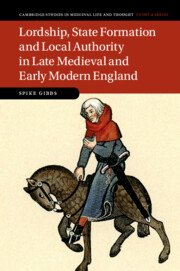Appendix 1 Categorising Presentments
Chapter 1 is largely based on the categorisation of presentments, the business brought by officials to manorial courts in response to charges made by stewards. Presentments were just one way business could be introduced to manorial courts, and thus a strict definition based on the phrasing within the rolls has been applied in identifying presentments. Only entries which begin with the statement ‘the [officer(s)] present that … ’ or ‘it is accounted by the [officer(s)] that … ’ followed by ‘and that … ’ have been counted. Crucially, this means the measure only charts the changing functions of presenting officials and not changes in the underlying business transacted in the court.
Presentments are useful as they covered a range of officials’ work and therefore can be categorised to explore the changing nature of officials’ roles. Five key categories are used:Footnote 1
1 ‘Lord’. This includes presentments directly relevant to the lord and his authority. Key areas include the monitoring of servile incidents, trespasses on seigniorial property, illicit land transactions outside the court, the lord’s rights to various types of forfeit property, collective payments made by tenants, and individual payments concerning rent and non-attendance at court.
2 ‘Royal’. This includes presentments related to meeting royal requirements. Key areas include peacekeeping, enforcing legislation such as the assize of bread and ale (which regulated the quality and sale of these products), maintaining royal roads and the tithing system, as well as collective payments to the monarch.
3 ‘Community’. This includes presentments focused on common issues for the community and its individual members. Key areas include the management of commons, maintenance of roads, fences and bridges, trespasses on tenants’ crops and the monitoring of bylaws.
4 ‘Land’. This includes presentments focused on land transfer. Key areas include inheritance and intervivos transfers (where living tenants transferred land).
5 ‘Misconduct’. This includes presentments designed to control misbehaviour.
Two further categories are included but not primarily used in the study:
6 ‘Monitor’. This includes presentments seen only at Worfield and Fordington. Owing to their leet structures, a substantial role for their juries leet was to confirm the presentments made by other officials.
7 ‘Nothing’. This includes all cases where officials explicitly said they had nothing to present.
There are two important limitations to the categorisation approach. On a practical level, the issue of record survival is paramount as it can change the number of presentments in any given decade. This is matched by changing numbers of sessions per decade caused by either increasing frequency or infrequency in the calling of courts. For the analysis, all decades which record at least ten presentments are included. Fortunately, there is no reason that changes in numbers of presentments surviving should have affected any category of business differently to the others, as presentment lists contained all the different categories intermingled. Thus, changes in proportions of presentment by category remain a valuable measure.
The second problem is that of deciding what business fits into each category, and even how to delineate the categories at all. This is thanks to the lord’s interest in all types of presentment. Manorial courts, including leets, were seigniorial jurisdictions, and existed to enforce the lord’s authority over his tenants. Therefore, to some extent lords were the beneficiaries of all presentments made in these courts; lords accrued the profits of amercements and the forfeited pains which resulted from punishments for presentment. Stewards, as the lord’s representative, had considerable influence over the presentment process. However, a crude division can be established between business where the lord was a direct beneficiary, for example in amercing tenants for failing to repair seigniorial property, and where he was an indirect beneficiary of the punishment, such as when an offender was presented for overstocking common land, where those affected by the offence were clearly the commoners rather than the lord.
Presentments concerning land prove the most difficult to fit into one category. For example, when it is presented that a tenant has died and that his or her heir must pay a heriot and entry fine to inherit the land, one could argue that the lord is the beneficiary, the jury ensuring he gets the revenue owed to him via the inheritance. However, at the same time, the jury is ensuring the correct inheritance of the land, allowing the heir his or her claim according to custom. Thus, even though inheritance presentments are enforcing a seigniorial right, the fact that they were effectively allowing tenants to transfer their land to their heirs means that they have been treated in the separate land category. In the case of intervivos transfers, these have been included if they were made legitimately in the court, even if on some occasions the beneficiary is presented as not coming to pay the entry fine due to the lord for taking on this property and consequently it is ordered to seize the land. This is because while this was ensuring the seigniorial right to profit from transfers, there was still at least an attempt by one party to make a legitimate transfer. In cases of alienation without any licence by the court, transfers have been categorised in the lord category.
1 Very rarely a jury presented some strictly interpersonal business. This has been ignored because it is recorded so inconsistently and is not pertinent to the topics explored here.

